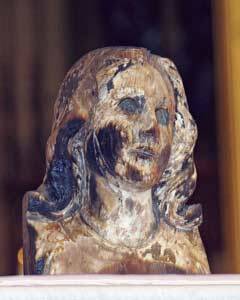I’m traveling with the statue of Mary, the survivor of the atomic bomb of Nagasaki,” said Archbishop Joseph Mitsuaki Takami of Nagasaki, Japan, before unlocking a security case and gently revealing its contents, a statue remnant, showing the ruined visage of Mary. “The message of this Mary is to tell the people of the world the absurdity and foolishness of war, militarization and nuclear weapons,” the archbishop told America. “Mary is inviting us to work for peace.” (Listen to the interview at www.americamagazine.org.)
The scorched head of Mary is all that remains of a statue that had once graced the main altar of Nagasaki’s Urakami Cathedral before it was destroyed by the atomic bomb, known as Fat Man, on Aug. 9, 1945. The archbishop was an unborn child in his mother’s womb when the second atomic bomb obliterated his hometown in a blast that killed 75,000 people.
Archbishop Takami has accompanied this Mary all around the world this year: to Guernica in Spain, to remember the first victims of the aerial bombing of civilians, and to Rome, where her image “quite moved” Pope Benedict XVI. “This Mary,” said Archbishop Takami, “accompanies all people who suffer from violence, especially the victims of war and conflicts.” On May 2 the archbishop brought Mary, perhaps one of the most compelling artifacts of Nagasaki’s inferno, to St. Patrick’s Cathedral in New York, where he concelebrated Mass. Archbishop Takami, who was in New York to attend the U.N. Review Conference of Parties to the Treaty on the Non-Proliferation of Nuclear Weapons, said he hoped the statue would focus attention on the enormous destructive power and inhumanity of nuclear weapons and on the importance of working toward their elimination. The partial bust depicts a haunting and tortured beauty, the eye sockets black and empty like the eyes of those who gazed into the fury of the initial flash.
“My message in bringing the statue is to ask, through the intercession of Mary, that such weapons no longer be used, that we work for peace,” the archbishop said after a Japanese-language Mass on May 2 for New York’s Japanese Catholic community at St. John the Evangelist Church. In a letter he wrote with Bishop Joseph Atsumi Misue of Hiroshima for the nonproliferation conference, Archbishop Takami called on world leaders to “take a courageous step toward the total abolition of nuclear weapons.”
“We, as the bishops of the Catholic Church of Hiroshima and Nagasaki in Japan, the only country to have suffered nuclear attacks, demand that the president of the United States, the Japanese government and the leaders of other countries make utmost efforts to abolish nuclear weapons,” the statement reads.
As a first step, the Japanese prelates called upon U.S. President Barack Obama to establish a policy of “sole purpose,” which would “limit the purpose of retaining nuclear weapons to deterring others from using such weapons only.” The archbishop said the people of Japan support the president’s nuclear disarmament efforts thus far and hoped to see him “concretize” the commitment he made toward nuclear weapons reductions in Prague last month in renewing arms reductions agreements with Russia. Archbishop Takami said the new reduction treaty with Russia was a first step, but that President Obama “should pursue this process toward the total elimination of nuclear weapons.”
Archbishop Takami has more than a purely spiritual or philosophical rationale for seeking the elimination of nuclear weapons. The Nagasaki blast claimed the lives of two of his aunts and his grandmother. A cousin died 14 years after the war from bomb-related illnesses. The archbishop was born on March 6, 1946, and raised in the long shadow cast by Nagasaki’s mushroom cloud. “My mother spoke about it, but not so many times,” he recalled. “Because she didn’t want to speak about it. Her experience was so sad.”
Listen to America's interview with Archbishop Joseph Mitsuaki Takami of Nagasaki.








